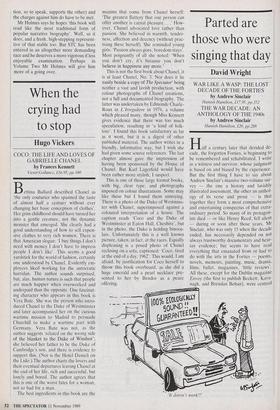When the crying had to stop
Hugo Vickers
COCO: THE LIFE AND LOVES OF GABRIELLE CHANEL by Frances Kennett Victor Gollancz, £16.95, pp.160 Bettina Ballard described Chanel as 'the only couturier who spanned the taste of almost half a century without ever changing her basic conception of clothes'. Her grim childhood should have turned her into a gentle creature, not the dynamic monster that emerged. She clearly had a good understanding of how to sell expen- sive clothes to very rich women. There is that American slogan: 'I buy things I don't need with money I don't have to impress people I don't like'. This seems a good yardstick for the world of fashion, certainly one understood by Chanel. Evidently em- ployees liked working for the autocratic harridan. The author sounds surprised, but, alas, human nature is such that people are much happier when overworked and underpaid than the opposite. One fascinat- ing character who appears in this book is Vera Bate. She was the person who intro- duced Chanel to the Duke of Westminster and later accompanied her on the curious wartime mission to Madrid to persuade Churchill to make a wartime pact with Germany. Vera Bate was not, as the author suggests 'related on the wrong side of the blanket to the Duke of Windsor'; she believed her father to be the Duke of Cambridge's son, and there is evidence to support this. (Nor is the Hotel Danieli on the Lido.) The author charts the lovers and their eventual departures leaving Chanel at the end of her life, rich and successful, but lonely and bored. The author agrees that this is one of the worst fates for a woman, not so bad for a man.
The best ingredients in this book are the maxims that come from Chanel herself: 'The greatest flattery that one person can offer another is carnal pleasure....' How- ever, Chanel advocated love rather than passion. She believed in warmth, tender- ness, affection and decency (without prac- tising these herself). She reminded young girls: 'Passion always goes, boredom stays'. Most poignantly of all she noted: 'When you don't cry, it's because you don't believe in happiness any more.'
This is not the first book about Chanel, it is at least Chanel, No. 3. Nor does it lie easily beside a copy of The Spectator' being neither a vast and lavish production, with colour photographs of Chanel creations, nor a full and documented biography. The latter was undertaken by Edmonde Charle- Roux in L'Irreguliere in 1974, a volume which pleased many, though Miss Kennett gives evidence that there was too much speculation, resulting in 'a kind of folk- lore'. I found this book satisfactory as far as it went, but it is a digest of other published material. The author writes in a friendly, informative way, but I wish she had given some source references. The last chapter almost gave the impression of having been sponsored by the House of Chanel. But Karl Lagerfeld would have been rather more stylish, I suspect.
This is one of those large format books, with big, clear type, and photographs imposed on colour illustrations. Some may like these but I found them annoying. There is a photo of the Duke of Westmins- ter with Chanel, superimposed against a coloured interpretation of a house. The caption reads 'Coco and the Duke of Westminster at Eaton Hall, Cheshire', but in the photo, the Duke is holding binocu- lars. Unfortunately this is a well known picture, taken, in fact, at the races. Equally displeasing is a posed photo of Chanel reclining on a sofa, captioned: 'Coco, tired at the end of a day, 1962'. This would, I am afraid, be justification for Coco herself to throw this book overboard, as she did a huge emerald and a pearl necklace pre- sented to her by Bendor as a peace offering.
'It doesn't work!!'










































































 Previous page
Previous page